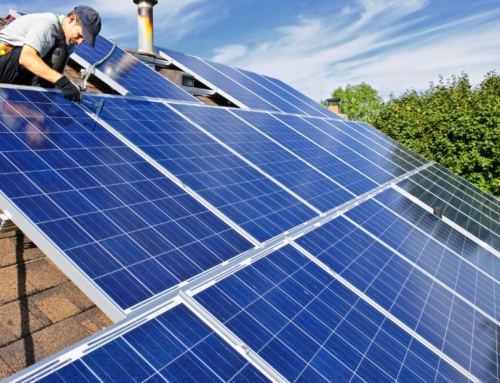As the world continues to grapple with impacts of climate change, reducing carbon emissions has become a top priority. But how do we accomplish the task at hand? Buildings have strong potential to make a difference, as they contribute to approximately one-third of greenhouse gas emissions in the U.S.
What is Building Decarbonization?
Building decarbonization is the systematic reduction of carbon emissions emitted from buildings. This involves transitioning away from fossil fuel-based energy sources, such as natural gas, coal, and oil, toward clean energy solutions like electricity generated from renewable sources (solar, wind, hydroelectric) and innovative technologies that enhance building efficiency.
The goal is to create structures that operate with minimal to no carbon impact, contributing to net-zero emissions targets that have been set by cities, states, and countries worldwide. Combined with energy efficiency strategies, building decarbonization plays a pivotal role in achieving a sustainable and climate-resilient future.
Key Strategies for Building Decarbonization
- Electrification: Shifting building systems like heating, cooling, and hot water production from fossil fuels to electricity, which can be sourced from renewables.
- Energy efficiency upgrades: Improving and updating insulation, windows, lighting, and appliances to reduce buildings’ overall energy consumption.
- On-site renewable energy generation: Installing solar panels or other renewable energy technologies to produce clean energy directly
- Retrofitting existing buildings: Upgrading older, energy-inefficient buildings to meet modern energy and carbon reduction standards through renovations, including high-efficiency HVAC systems and weatherization improvements.
How Building Decarbonization Relates to the Greenhouse Gas Reduction Fund (GGRF)
The Greenhouse Gas Reduction Fund (GGRF) is a landmark $27 billion federal initiative aimed at cutting carbon emissions and accelerating the transition to a clean energy economy. Established through the Inflation Reduction Act (IRA) of 2022, the GGRF directs funding toward projects and initiatives that reduce greenhouse gas emissions and other pollutants, particularly in low-income and historically underserved communities. Administered by the Environmental Protection Agency (EPA), the GGRF mobilizes financing and private capital, expanding clean energy infrastructure, and enhancing community resilience to climate change.
One of the core components of the GGRF is supporting building decarbonization efforts by providing accessible financing to communities looking to invest in energy-efficient technologies and clean energy upgrades. It leverages public and private partnerships to reduce the cost of implementing decarbonization strategies, making it easier for people and organizations to take action in reducing their carbon footprint.
How Energy Efficiency and Building Decarbonization Work Together
Building decarbonization and energy efficiency are deeply interconnected. Energy efficiency reduces the amount of energy required to operate a building, while decarbonization ensures that the remaining energy demand is met through clean, low-carbon sources. Together, they create a holistic approach to transforming the built environment for a sustainable future.
Here’s how they complement each other:
- Energy Efficiency Reduces the Load: Energy efficiency measures such as better insulation, LED lighting, advanced heating and cooling systems, and energy-efficient appliances all work to lower a building’s overall energy consumption. This means that when buildings are eventually electrified and powered by renewable energy, they need less energy to function, resulting in fewer emissions.
- Lowering Costs and Enhancing Feasibility: One of the primary challenges of building decarbonization is the upfront cost of electrification and renewable energy technologies. Energy efficiency can reduce these costs by lowering the energy demand, allowing for smaller and more affordable renewable energy systems to be installed. For instance, a building with improved insulation will require a smaller heat pump system to maintain comfortable temperatures, reducing both the initial cost and ongoing energy consumption.
- Maximizing the Impact of Renewable Energy: Energy efficiency and decarbonization work together to ensure that the energy produced from renewable sources, such as rooftop solar panels, is used as effectively as possible. An energy-efficient building makes the most of the clean energy it generates, ensuring that it covers a significant portion of the building’s energy needs and accelerating the path to net-zero emissions.
- Resilience and Comfort: Energy-efficient buildings are not only more environmentally friendly; they are also more comfortable and resilient. Improved insulation and energy-efficient windows help maintain consistent indoor temperatures, even during extreme weather events. This reduces the reliance on heating and cooling systems, which can fail or become strained during periods of high demand. In the long term, these energy-efficient buildings are better equipped to handle the impacts of climate change—therefore improving building resiliency.
Looking Ahead: A Unified Strategy for Sustainability
The path to decarbonizing buildings is not an easy one, but the combined power of energy efficiency and clean energy technologies can make it achievable. Federal programs like the Greenhouse Gas Reduction Fund (GGRF) provide financial support to accelerate these efforts, particularly for low-income and underserved communities that have historically lacked access to clean energy solutions. By prioritizing energy efficiency, leveraging renewable energy, and reducing carbon emissions from buildings, we can create a sustainably built environment that benefits everyone and plays a critical role in mitigating climate change. CCEF is grateful for the opportunity to play a part as a sub-awardee of the GGRF’s National Clean Investment Fund to support the advancement of decarbonization of buildings across EPA Region 8, with a focus on low-income and disadvantaged communities.







